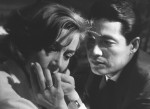Figures covered in dust and ash, writhing: arms, legs, backs, torsos exposed, transfixed and transposed in time and space. A back-and-forth banter between a man and a woman begins on the audio track as brief newsreel footage of Hiroshima’s wreckage flashes across the screen. “You saw nothing at Hiroshima – nothing,” the man says.
This mesmerizing scene juxtaposing eroticism with war-torn lamentations opens Alain Resnais’s 1959 movie, “Hiroshima Mon Amour.” The film, considered by many to be one of the most influential of its day, is playing at Laemmle’s Royal Theatre in a newly restored print from Rialto Pictures.
Resnais’s first feature centers on two people – one a French movie actress (Emmanuelle Riva) and the other a Japanese architect (Eiji Okada) – embroiled in a steamy affair in a Hiroshima still reeling from the atom bomb. Over the movie’s duration, they make love, they smoke cigarettes and they wander aimlessly while discussing their lives and worldviews, knowing very well their love is an inevitably fleeting and impossible one.
Just as in Resnais’s next film, 1961’s “Last Year at Marienbad,” the names of the two central characters are never revealed. The two lovers are left deliberately anonymous, referred to only as Elle and Lui, French for “Her” and “Him,” respectively. In addition, very little information is given about their past. Elle’s dead former lover and hometown life and Lui’s military service is almost all that is revealed to us. This creates distance between the two characters, as well as between them and the audience. If we don’t know even know their names, how can we relate? In the end that is the point: This is a film about barriers.
The other key theme of the film is that of remembering or, more precisely, of forgetting. This dichotomy between memory and the loss of memory plays out repeatedly, from misremembered events to conflicting recollections.
“Hiroshima Mon Amour” does not present itself as a linear love story but instead as a series of fragmented memories and snippets of bedside conversations, of scenes pieced together to give an impression, a cloudy estimation of a brief relationship.
It is as though someone took apart a traditional romance movie narrative and then reassembled it into some recognizable yet strangely indistinct form. Shifting chronology and contradictory exchanges further distorts the film’s reality, lending the production a perplexing, mysterious and always fascinating atmosphere.
With this movie, Alain Resnais crafted one of cinema’s great debut features. Like “Citizen Kane” before it and “Breathless” directly after it, “Hiroshima Mon Amour” was a drastic departure from movies that came previously. In this respect, it is an active rebellion played out in cinematic terms.
One gets the sense that Resnais’s intention is to create a new filmic language, and he achieves this: establishing a style perhaps most closely aligned with literature’s “stream of consciousness,” popularized in the early part of the 20th century. Disjointed, elliptical and self-reflexive, “Hiroshima Mon Amour” set the stage for later works made in a similar style, such as the famed essay films of Chris Marker.
Nearly as innovative and imaginative today as it must have been in 1959, “Hiroshima Mon Amour” is both a classic film and a truly modern one. It is a stunning portrayal of love and loss within a post-war landscape.
– Ian Colvin
